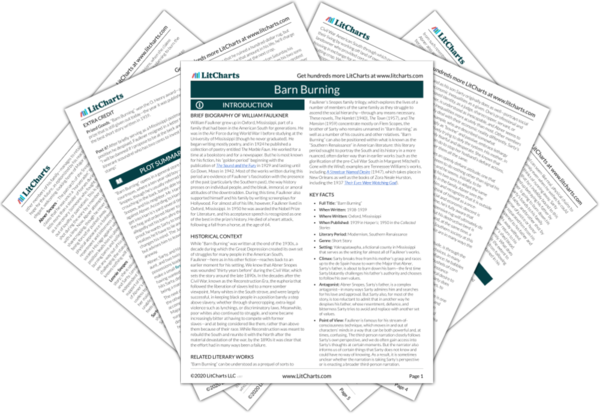The Snopes family is made up of poor white sharecroppers, an economic class from the post-Civil War American South through which poor farmers earned their living by working off land of owned by another, a landowner who provided certain materials and sometimes housing in exchange for the labor and a percentage of the resulting crop. While former slaves often became sharecroppers in the upheaval after the Civil War and Reconstruction, struggling white people increasingly turned to it as well, even though the system could be grueling and unforgiving, with many sharecroppers entering a cycle of debt to their landowners from which they might never emerge.
Abner Snopes, the patriarch of the Snopes family, is deeply resentful of his economic situation—but this resentment is also racial. Economically, the Snopes family has much more in common with other black sharecroppers, or even with the black servants who work at the de Spain house, than with the white landowners. And racial prejudice is not, of course, limited to the Snopes family, in American history or in this story. It appears that part of the reason the black servants at Major de Spain’s house are so terrified when Abner soils the rug is that they live in such fear of their master.
But Abner in particular finds it vital to distinguish himself from black people in order to cling to one last sense of superiority and self-respect. And Abner uses his prejudice to justify his own superiority to everyone else. For instance, he positions himself as superior to the much richer de Spain family because their house is built, he says derogatorily, from “nigger sweat.” In other words, Abner has found a way to make his own status as a poor white person one of “purity” based on his prejudice. He holds black people as naturally inferior to him because he is white. But he also holds wealthier white people as inferior to him because they use their money to hire black labor, and thereby are surrounded by black people. Under this prejudicial logic, Abner as a poor white person is superior because he neither is black nor can hire blacks. And his ideas seep into the rest of the family—Abner’s son, Sarty, also uses derogatory language in talking about blacks, even if he hasn’t developed as full-bodied a logic of racism as his father.
Yet the story also makes clear that Abner’s viewpoint is ultimately motivated by resentment at the fact that he and the black servants are in the same position, his “white sweat” mixing with theirs. Such ugly prejudices are, the story suggests, meant to be seen in part as an element of Abner’s own personal resentment and selfishness. But they are also portrayed, through the story’s broader portrait of the society in which Abner lives, as indicative of the larger racial and economic relationships that underlie—and warp—the entire American South.
Resentment, Race, and Prejudice ThemeTracker

Resentment, Race, and Prejudice Quotes in Barn Burning
He could not see the table where the Justice sat and before which his father and his father’s enemy (our enemy he thought in that despair, ourn! mine and him both! He’s my father!) stood.
And older still, he might have divined the true reason: that the element of fire spoke to some deep mainspring of his father’s being, as the element of steel or of powder spoke to other men, as the one weapon for the preservation of integrity, else breath were not worth the breathing, and hence to be regarded with respect and used with discretion.
And now the boy saw the prints of the stiff foot on the doorjamb and saw them appear on the pale rug behind the machinelike deliberation of the foot which seemed to bear (or transmit) twice the weight which the body compassed.
“Pretty and white, ain’t it?” he said. “That’s sweat. Nigger sweat. Maybe it ain’t white enough yet to suit him. Maybe he wants to mix some white sweat with it.”
He saw the man in spectacles sitting at the plank table and he did not need to be told this was a Justice of the Peace; he sent one glare of fierce, exultant partisan defiance at the man in collar and cravat now, whom he had seen but twice before in his life, who wore on his face an expression not of rage but of amazed unbelief which the boy could not have known was at the incredible circumstance of being sued by one of his own tenants.
















